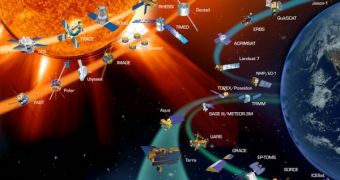According to the 12th World Market Survey released by the Paris-based trend company Euroconsult, satellite manufacturers have nothing to fear over the next ten years, until 2018. The market will continue to grow, but, at the same time, the prices of launches will increase only slightly, and may even drop, after inflation is taken into account. The new report compares the forecast satellite production over the next ten years with that occurring between 1998 and 2008.
The study took into account the commercial, civil government and military sections of the industry, in order to offer the most complete image possible. It also reveals the fact that the average weight of the orbital instruments will decrease to 4,166 pounds (1,890 kg), a five-percent drop from the average of the last decade. The decrease is mostly owed to the fact that more sophisticated technologies allow for more equipment to be placed in a tighter space. Additionally, innovations in construction materials will also decrease the weight on the containers that carry the active components of future missions.
The company also revealed that commercial satellite launches would not follow the general trends on the market over the next decade. Euroconsult foresees that the three mobile voice and data low-orbiting satellite constellations, Globalstar, Iridium and Orbcomm, will most likely move to replace their aging satellite fleets, which means that between 130 and 160 second-generation instruments could be launched by these three operators alone, Space informs. The report also shows that the commercial market, mostly made up of telecommunications satellites in geostationary orbit, will increase by about 15 percent, to about 234, considering scheduled and potential launches to take place between 2009 and 2018.
One of the main reasons why prices for launches will drop is the fact that India and China, the two emerging superpowers of the moment, will begin to launch their own satellites, and will eventually offer services to other contractors, most likely at prices under those practiced by the ESA, JAXA, NASA, RosCosmos or Arianespace, which are the main players on the launch market at the moment. However, the trends do not include micro- and nano-satellites, weighing less than 40 kilograms, or top-secret military satellites, from the US, Russia and, potentially, China.

 14 DAY TRIAL //
14 DAY TRIAL //